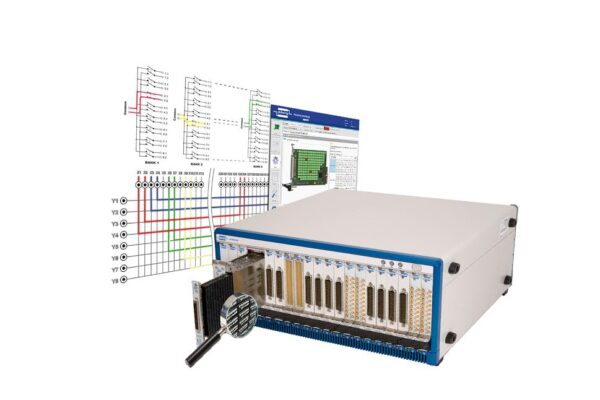
Pickering Interfaces’ eBIRST FAQ
However, the switching system is in a vulnerable place, and accidents may happen during development or when a connection is made to a faulty device. When those accidents happen you need a way to get the system up and running again with the minimum of effort and operator skills – because until the switching system is repaired the test system cannot be used. That is where the new eBIRST switching system test tools from Pickering Interfaces come in.
The eBIRST tools provide a means of quickly determining if your switching system has faults, identifies where that fault is located at relay level and allows you to take fast corrective action. This in turn saves on repair costs and minimizes downtime of your switching system. No other switching system manufacturer offers this level of support for their products.
Here are some answers to the most commonly asked questions about the eBIRST tools.
Q: What exactly do the eBIRST tools do and what are the benefits?
A: The eBIRST tools provide a means of quickly determining if a switching system has faults, identifies where that fault is located at relay level and allows the user to take fast corrective action. The tools greatly lower MTTR (Meant Time To Repair), saving users repair costs by allowing for fast local repair rather than return to factory, while allowing development to proceed or to minimize the downtime of manufacturing systems.
Q: What kind of switching systems do the eBIRST tools support?
A: The eBIRST tools support any of Pickering Interfaces PXI, PCI or LXI (Ethernet) controlled switching systems that have consistent path resistance at low signal levels. Through the use of three tools based on 200-way LFH, 78-way D-type and 50-way D-type connectors and a set of adaptors, a wide range of switching systems can be covered. These typically include all the highest density and complexity switching systems based on reed relays, low and medium power (typically 2A or less) EMR’s and low frequency solid state relays.
Q: How do the eBIRST tools work?
A: They work by measuring the path resistance at the switching system’s connectors using four-wire tool measurements. This measurement quickly establishes if the path is good, has increased resistance or has failed.
Q: What is needed to make use of the eBIRST tools?
A: The eBIRST tools are self-contained; all you will need is a USB2 port on a PC running Windows and the supplied application program to control them. The USB control port provides power for the tools. Adaptors used with the eBIRST tools are recognized and checked to make sure they are compatible with the switching system to be tested. The program uses a Test Definition File created for each switching system that defines how to test the system. Test Definition Files and the application program can be downloaded from the Pickering Interfaces website (pickeringtest.com/ebirst) free of charge to update the application program.
For some switching systems, there may be inputs on one connector and outputs on another, requiring a through path measurement between the two connectors to be carried out using two eBIRST tools. In order to make this connection, we offer a Master/Slave Cable that connects to the rear of the two tools allowing them to work together. The application program controls both tools to make a measurement between the two connectors; the connectors do not have to be the same type if the switching system requires them to be different. The Master/Slave Cable connection is generic across all of the tools.

Q: What can be tested with the eBIRST tools?
A: Almost any switching system that has a consistent path resistance at a current of 30mA or less, the test current used by the eBIRST tool. This includes RF switching systems that are DC coupled and use SMB connectors. The eBIRST tools do not cover switching systems based on high current relays as they are potentially subject to minimum switching capacity issues that can result in unpredictable path resistance and, therefore, false failure reports. The 30mA test current is considerably higher than that used in DMM based testing.
Q: Can eBIRST tools test other switching systems?
A: Pickering Interfaces eBIRST tools are designed to support the Pickering Interfaces family of switching systems only. At this time, there are no plans to broaden this scope.
Q: How can eBIRST tools be made traceable and checked?
A: Functionality and accuracy of the eBIRST tools can be checked with the aid of an external calibration fixture that allows users to either connect two tools together or measure a set of fixed value precision resistors. The two tools are controlled to perform a cross-check of their functional performance and the precision resistors on the fixture allow the tool to check for measurement accuracy. The resistors in the fixture can be checked using a user supplied calibrated DMM to ensure traceability.
Q: What steps are necessary to run a test?
A: Connect the eBIRST tool to the switching system, via an adapter if required. The switching system can be PXI, PCI or LXI based; it makes no difference as long as it uses a connector supported by the eBIRST tools. Then simply run the supplied application program
Q: Does the user need to configure the tool for a different switching system to be tested?
A: For each switching system to be tested there is a Test Definition File that describes the tests to be performed and the limits to be applied. If the required Test Definition File is not present, a newer version of the eBIRST application program needs to be installed. Pickering Interfaces will continually expand the availability of Test Definition Files to cover all supported switching systems.
Q: How do I find out where faulty relays are physically located?
A: The eBIRST tools will quickly test the switching system, locate the faulty relay(s) and inform you what relays to replace via a graphical output. This output identifies the relays that need attention and where physically they are on the switching system.
There is no need to refer to manuals to use lengthy cross reference tables that convert a functional position (e.g. X-Y co-ordinates on a matrix) to relays designation (e.g. RL123), then try to find it on the PCB layout. Instead, the eBIRST tools show you a layout of the PCB and exactly where the defective relays are on that layout. The eBIRST tools make fault location easy in order to simplify the repair task.
Q: What if my switching system doesn’t look to be supported by eBIRST?
A: Contact Pickering to request it – If there are no technical reasons why we can’t support the system (a minority of our switching systems cannot be supported for various technical reasons), we will add a Test Definition File to the application program.
Q: What happens after a repair is carried out?
A: After carrying out repairs as required, reconnect the test tool and run the application program again to check that repairs were successful. Ideally try to find why the failure occurred (relay failures usually have an external cause). Then re-deploy the switching system. Provided repairs have been done correctly, our policy is that there is no impact on the 3-year warranty offered by Pickering Interfaces.
Q: Pickering has had the BIRST (Built-In Relay Self-Test) feature on its high-value matrices for years. So why use eBIRST tools and why are they better?
BIRST is a tool internal to our matrix switching modules. While it can test relay paths in the matrix and report errors, it is less accurate and only works internally. For example, it does not test for connector issues. The eBIRST tools, however, will test most of the other switching in your system. Finally, one set of eBIRST tools can support an entire test floor, keeping your support costs low. I would recommend any test department manager to review their test system support strategy and to consider using Pickering Interfaces switching and eBIRST as part of their plan to maximize test system uptime.
So – the main question should be: Why choose Pickering products supported by the eBIRST switching system tools?
Users buy switching systems to test products. When the switching system develops a fault, it causes downtime, consumes an engineer’s time to diagnose the fault and delays projects. So when problems occur—instead of figuring out how to identify and rectify the fault, get your eBIRST tool, connect it to the system and run the test.

The eBIRST tools will quickly test the switching system, locate the faulty relay and inform you what relays to replace. Downtime is considerably reduced, and the problems of misdiagnosed faults causing ineffective repairs to be carried out are minimized.
So along with Pickering’s diagnostic test tools, standard three-year warranty and long-term product support, no other switching system manufacturer offers this level of support for their products. Pickering and eBIRST should be considered as part of your test system support strategy.
About the author:
David Owen is Pickering Interfaces’ Business Development Manager – www.pickeringtest.com
 If you enjoyed this article, you will like the following ones: don't miss them by subscribing to :
eeNews on Google News
If you enjoyed this article, you will like the following ones: don't miss them by subscribing to :
eeNews on Google News



